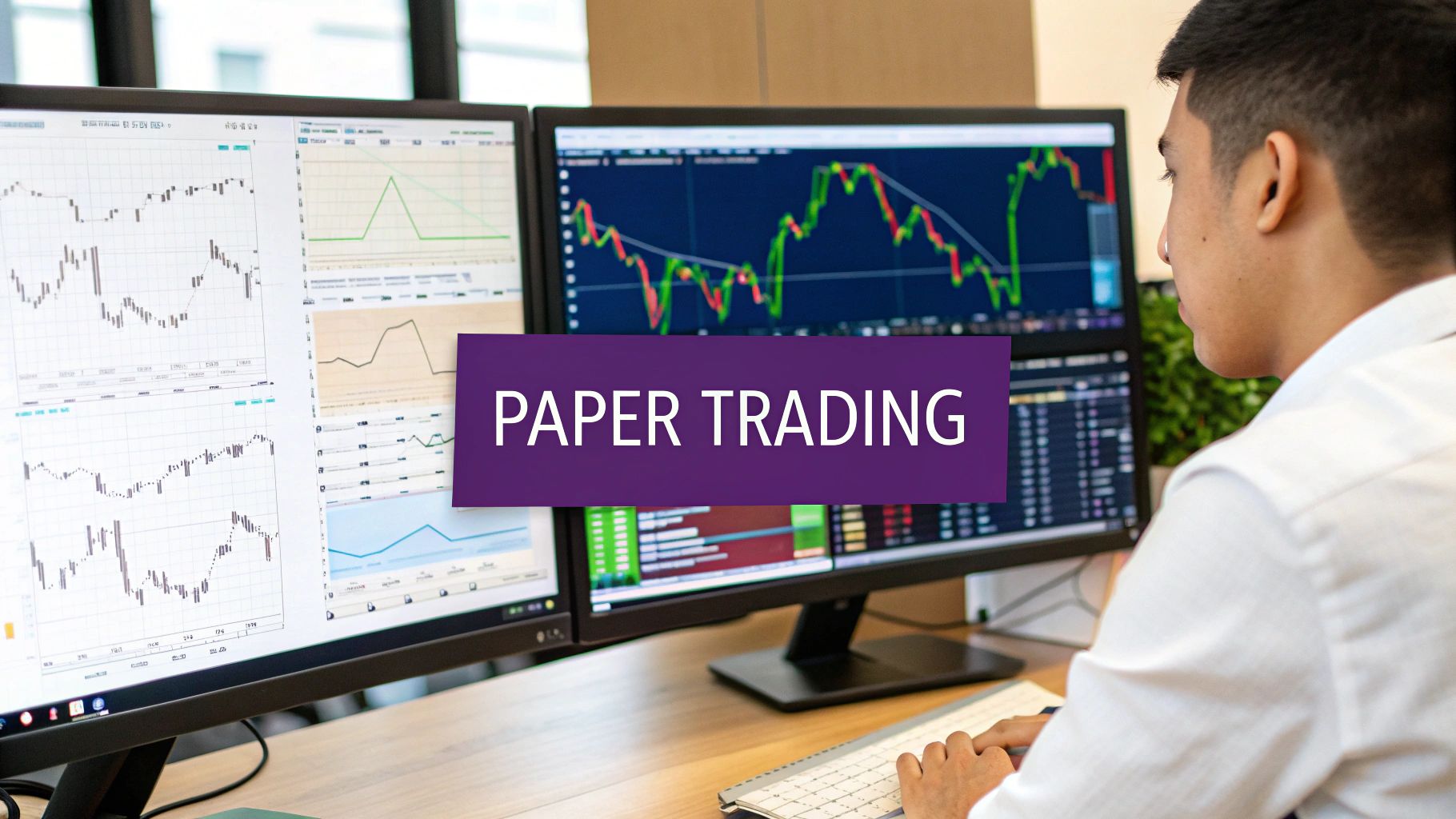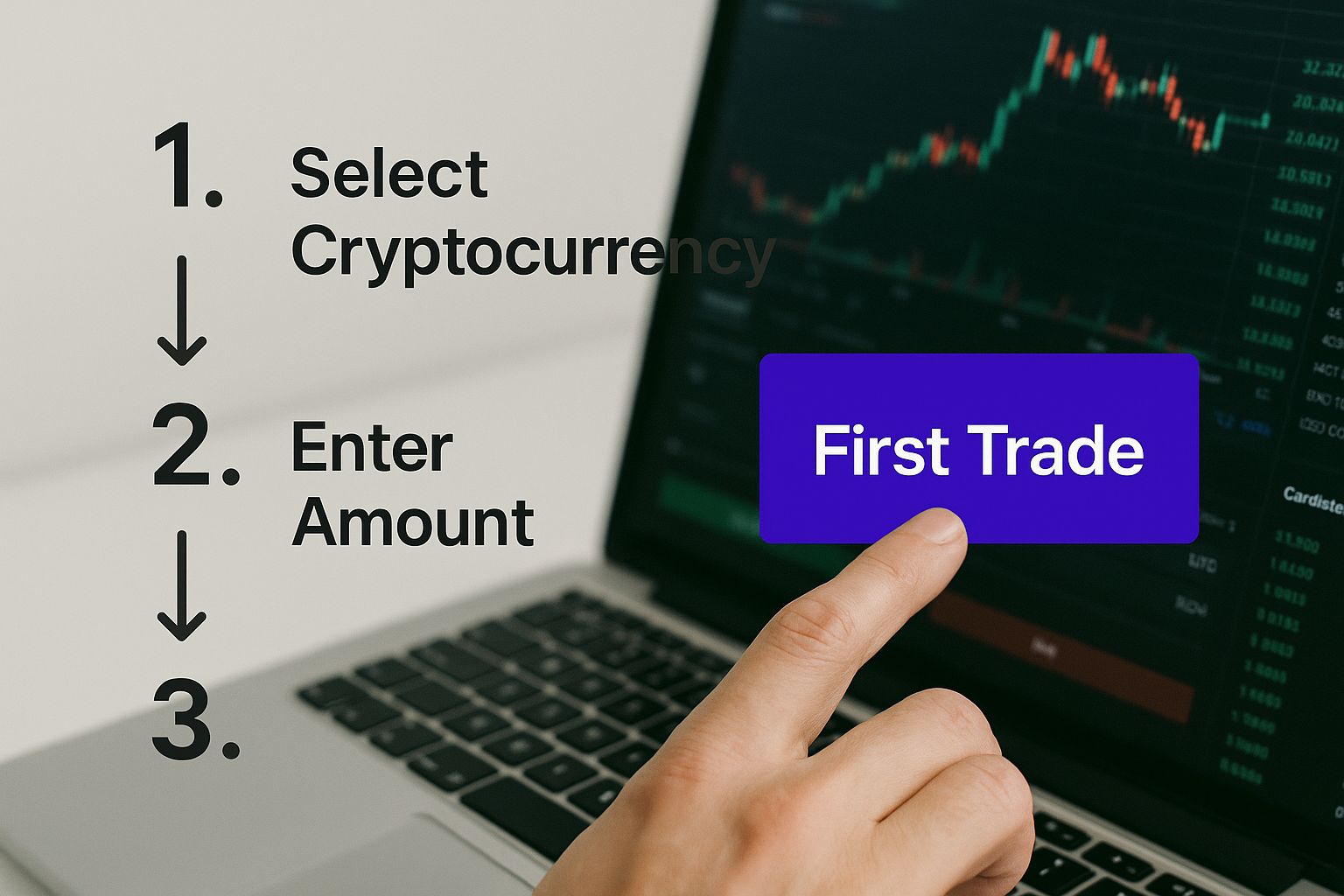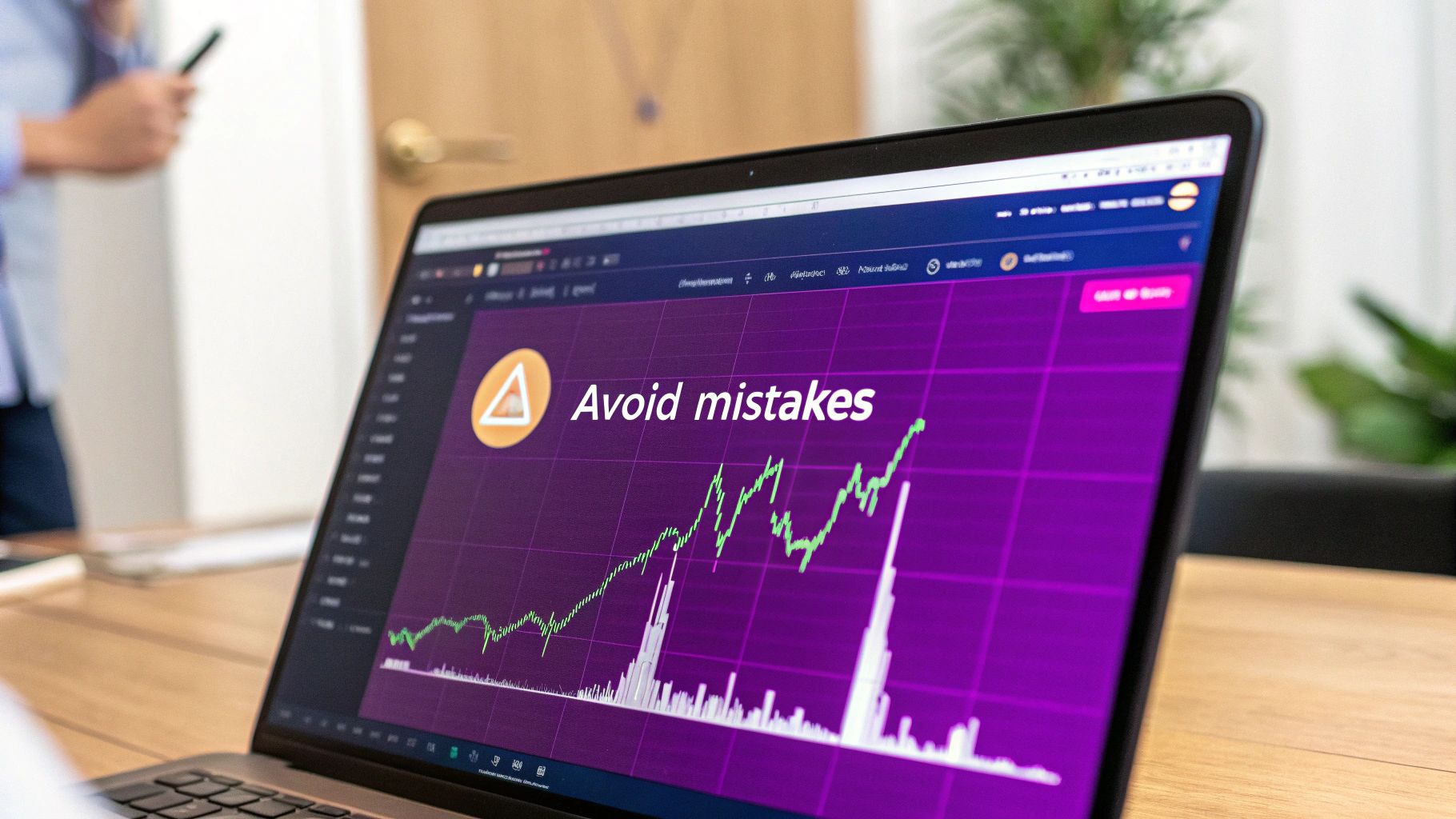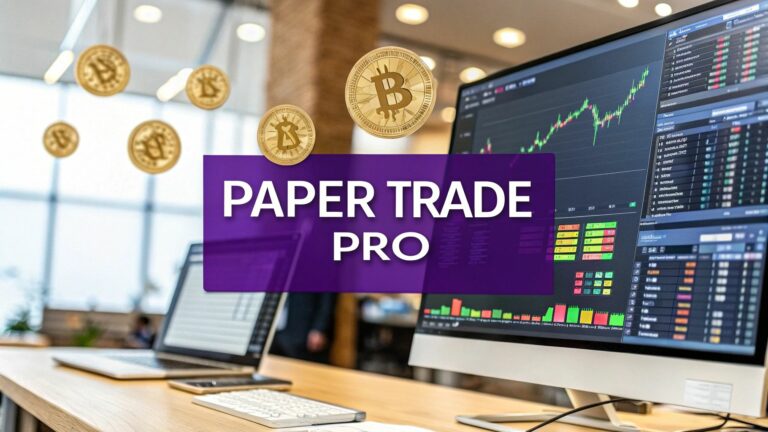Before you even think about putting real money into the crypto market, we need to talk about the single most important first step: paper trading.
Think of it as your personal training ground. It's a full-on market simulator where you trade with virtual money, letting you learn the ropes without any of the real-world financial risk. This is, without a doubt, your secret weapon for building the confidence and skills you'll need before you ever place a live trade.
Why Paper Trading Is Your Secret Weapon

Jumping straight into crypto trading without any practice is like trying to fly a helicopter after just reading the manual. It's a recipe for disaster. A crypto paper trade account gives you that crucial simulator training.
It’s a completely risk-free sandbox where you can experiment with different strategies, make all the rookie mistakes, and really get a feel for the market's rhythm—all using fake money.
But this goes way beyond just learning which buttons to click. Paper trading is a deep dive into the psychology of the market. You get to feel the emotional highs and lows of a trade going your way (or against you) without the gut-wrenching stress of watching your actual bank balance shrink.
Master Your Emotions and Strategy
The real magic of paper trading is in how it helps you build discipline. It’s the perfect place to create a trading plan, test it, and see how you react when the market gets choppy. This is where you learn to tame common emotional traps like the Fear of Missing Out (FOMO).
By practicing consistently, you start to connect the dots:
- Market Dynamics: You'll see firsthand how breaking news, shifting sentiment, and technical signals can make prices swing wildly in real-time.
- Strategy Validation: Does your day trading idea actually work? Can your swing trading thesis hold up? This is where you find out.
- Risk Management: You'll get comfortable setting stop-loss and take-profit orders, learning how to protect your "capital" and secure gains mechanically.
To give you a clearer picture, here's a quick rundown of what makes paper trading so valuable.
Key Benefits of Paper Trading at a Glance
| Benefit | Description | Real-World Impact |
|---|---|---|
| Risk-Free Learning | Trade with virtual funds in a live market environment without risking any real capital. | You can make mistakes, learn from them, and develop your skills without financial consequences. |
| Emotional Discipline | Experience the psychological pressures of trading without the stress of actual monetary loss. | Helps you build emotional resilience and avoid impulsive decisions driven by fear or greed. |
| Strategy Testing | Test and refine your trading strategies (e.g., day trading, swing trading) with real market data. | You enter the real market with a proven playbook, increasing your confidence and potential for success. |
| Platform Familiarity | Get comfortable with the trading platform’s interface, order types, and charting tools. | Reduces the chance of costly execution errors when you start trading with real money. |
Ultimately, a simulator helps you turn theory into practice, which is the only way to build sustainable skills in this market.
Build a Foundation of Knowledge
To get the most out of paper trading, you first need to understand the fundamental cryptocurrency trading basics. A paper trading account is where you bring those concepts to life. It’s where abstract ideas become practical, repeatable skills.
Paper trading is the bridge between knowing the theory and having the experience. It allows you to build a playbook of strategies that you've personally tested and can trust when real capital is on the line.
Before you invest your first dollar, invest your time. The lessons you learn in the simulator will pay dividends long after you’ve made the switch to a live account.
And if you want to sharpen your skills even further, check out the resources available at the vTrader Academy over at https://www.vtrader.io/en-us/academy.
Finding the Right Crypto Paper Trading Platform
Picking where you’ll practice your crypto trading is a bigger deal than you might think. Your choice of platform will make or break how quickly you learn the ropes.
Some platforms are loaded with sophisticated analytical tools, while others are laser-focused on creating a perfect copy of a real exchange’s trading floor. There's a subtle but important difference.
The goal is to match the platform to what you actually want to learn. Are you trying to get good at technical analysis and become a master of the charts? Or is your main goal just getting the feel for placing orders on the exchange you plan to use with real money? Your answer changes everything.
Standalone Charting Tools vs. Exchange Simulators
Your choices boil down to two main camps, and knowing the difference is key to picking the right tool for what you need to do.
-
Charting Platforms (e.g., TradingView): These are the undisputed kings of technical analysis. They give you a massive arsenal of indicators, drawing tools, and ways to customize your view that you just won't find on a regular exchange. If you want to become an expert at reading charts, this is where you need to be.
-
Exchange Demo Accounts (e.g., Binance, Bybit): These platforms are all about realism. They give you an exact replica of their live trading environment—same interface, same order types, same coin listings. This is the best way to build muscle memory and get comfortable with the workflow of a specific exchange before you put real cash on the line.
Honestly, the best move is to use both. Get your strategy dialed in on a platform like TradingView, then jump over to a demo account on your chosen exchange to practice the actual execution. This gives you the best of both worlds.
Key Features to Compare
When you're sizing up different platforms, look past the slick marketing. A pretty interface doesn't mean much if the data lags or the toolset is weak.
Here’s a quick rundown of what really matters:
| Feature | What to Look For | Why It Matters |
|---|---|---|
| Market Data | Real-time or near-real-time data feeds. | Practicing with delayed data is like training for a race in slow motion. You need to react to the market as it moves. |
| Coin Variety | A wide selection of trading pairs, especially the ones you care about. | A poor selection ties your hands, preventing you from exploring different assets and market trends. |
| Analytical Tools | Strong charting capabilities, technical indicators, and drawing tools. | These are non-negotiable for developing and testing any strategy that relies on technical analysis. |
| User Interface (UI) | An intuitive interface that feels like a real trading platform. | A clunky or confusing UI can cause you to make mistakes. Practicing on a similar interface builds confidence. |
Just look at the charting interface on a platform like TradingView. The depth of analytical tools available for paper trading is immediately obvious.
This kind of setup lets you stack multiple indicators, draw trendlines, and analyze price action with a level of detail you absolutely need for serious strategy development.
At the end of the day, you want a platform that gets out of your way and lets you learn. You can always explore crypto paper trading on a few different platforms to see which one clicks. The right simulator feels less like a game and more like a professional tool built to help you win.
Executing Your First Crypto Paper Trade
Alright, you've got the "why" behind paper trading and know what to look for in a platform. Now for the fun part: getting your hands dirty without risking a single cent. This is where theory gets real, and you start building the instincts of a trader.
Let's walk through a classic scenario. Say you’ve been watching Ethereum (ETH) and you're convinced it's about to bounce back after a recent dip. Your mission, should you choose to accept it, is to practice buying that dip in a simulated environment.
This visual guide breaks down the core steps for placing that first trade.

From picking your asset to hitting that final "confirm" button, every action helps build the muscle memory you’ll need when real money is on the line.
Finding Your Way Around the Trading Dashboard
When you first log into a demo account, the dashboard can look like the cockpit of a spaceship. Don't let it intimidate you. Just focus on the essentials: the price chart, the order book (where you see all the current buy and sell orders), and the order entry form.
Your first job is to find the right trading pair. In our Ethereum example, you’ll be looking for ETH/USD or ETH/USDT. This simply means you're trading Ether against either the US Dollar or Tether.
Choosing Your Order Type
This is a critical decision. How do you actually enter the trade? You’ve got two main options to start with:
- Market Order: The simplest and fastest way to get in. A market order tells the platform to buy (or sell) ETH immediately at the best price currently available. It’s all about speed and guarantees your order gets filled, but you don't have control over the exact price.
- Limit Order: This is where you take control. You set the exact price you’re willing to pay. Your order only goes through if and when the market hits your target price.
Since we're trying to buy the dip, a limit order is usually the smarter move. If ETH is trading at $3,550, but you think it will briefly drop to $3,500 before it rallies, you can set your limit buy order right there. This way, you avoid overpaying if the price suddenly shoots up before you can react.
Pro Tip: Always, always double-check your order details before you confirm. It’s incredibly easy to add an extra zero or mix up buy and sell in a fast-moving market. Paper trading is the perfect time to burn this habit into your brain.
Setting Your Risk and Profit Targets
A good trade isn't just about the entry—it's about knowing when to get out. You need to define your exit points before you even place the trade.
First, set your stop-loss order. This is your safety net. It's a pre-set order that automatically sells your asset if the price drops to a certain level, protecting you from a catastrophic (even if virtual) loss. If we buy ETH at $3,500, we might set a stop-loss at $3,430, which caps our potential loss at 2%.
Next, define your take-profit order. This is the fun one. It automatically sells your position once it hits your profit goal. If your analysis tells you ETH is heading for $3,675, you can set your take-profit order there and lock in those gains without having to watch the screen 24/7.
Don't forget that trading fees eat into profits. On some networks, these costs can be a huge factor. It's a good idea to check something like an ETH gas tracker to see how network congestion is affecting transaction costs in real-time.
With crypto adoption on the rise—the U.S. alone is projected to have nearly 100 million crypto users by 2025—the need for risk-free learning tools has never been greater. Paper trading is how newcomers can build confidence and skills before diving into the deep end.
How to Test and Refine Your Trading Strategy
https://www.youtube.com/embed/OwvElpGjLKI
Making your first crypto paper trade is a solid first step, but real progress happens when you move beyond one-off trades and start building a cohesive, repeatable strategy.
Winning in the long run isn't about getting lucky. It’s about having a system, and your paper trading account is the perfect lab to build and fine-tune it without putting a single dollar on the line.
This is the part where you shift from just practicing clicks to thinking like a pro. The goal is to build a playbook that you’ve already battle-tested in a simulation, giving you a huge advantage when you finally decide to trade with real money.
Building Your Strategy Sandbox
First things first: you need to define what you're actually testing. Just buying and selling random coins based on gut feelings won’t teach you much of anything.
Instead, pick a specific, well-known strategy and treat it like a science experiment. Your job is to see if it actually works for you and the assets you’re interested in.
Here are a few popular approaches you could start with:
- Day Trading: This is all about catching small price moves within a single day. Can you consistently pull profit from the intraday volatility of a specific altcoin?
- Swing Trading: Here, the goal is to capture bigger price swings over several days or even weeks. It requires more patience and a good handle on trend analysis.
- Dollar-Cost Averaging (DCA): This involves investing a fixed amount of money at regular intervals, no matter the price. While it’s more of an investment strategy, simulating it can help you understand its long-term impact on a portfolio.
Let’s say you want to test a moving average crossover strategy on Solana (SOL). You could form a hypothesis like: "I'll buy SOL when its 20-day moving average crosses above the 50-day moving average and sell when it crosses below." Let that simulation run for a month and see what the results tell you.
Comparing Popular Trading Strategies to Test
To get started, you need a clear framework for what you’re testing. Different strategies fit different personalities and require tracking different metrics. This table breaks down some common approaches you can validate in your paper trading account.
| Strategy | Timeframe | Best For | Key Metric to Track |
|---|---|---|---|
| Day Trading | Minutes to Hours | Traders who thrive on high-frequency action and quick decisions. | Win/Loss Ratio |
| Swing Trading | Days to Weeks | Patient traders who can identify and ride market trends. | Average Profit Per Trade |
| Position Trading | Weeks to Months | Long-term thinkers focused on major market movements. | Max Drawdown |
| Scalping | Seconds to Minutes | Highly disciplined traders making dozens of tiny trades a day. | PnL vs. Fees Paid |
| DCA | Ongoing | Investors looking to build a position over time, minimizing volatility. | Average Entry Price |
Think of this as your menu of options. Pick one that aligns with your available time and trading style, then dedicate your paper trading account to mastering it.
Tracking and Analyzing Your Performance
If you’re not tracking your trades, you’re just gambling. Your most powerful tool for improving is a trading journal. It can be a simple spreadsheet or a dedicated app, but it absolutely must capture the critical details of every move you make.
A good journal goes beyond just the numbers. For every single trade, you should be recording:
- The Setup: Why did you take this trade? What specific technical or fundamental signal triggered your entry?
- Your Mindset: How were you feeling? Confident? Anxious? Were you chasing a pump out of FOMO?
- The Outcome: The profit or loss, both in dollars and as a percentage of the trade.
- The Review: What went right? What went wrong? What would you do differently next time?
This is non-negotiable. By consistently journaling, you create a feedback loop that turns every trade—win or lose—into a priceless lesson. All this data is what you’ll use to calculate key metrics like your win-loss ratio and average profit per trade.
Over time, this journal will start to reveal your patterns, both good and bad. You might discover you're a natural at spotting swing trade setups but get chopped up in the fast-paced environment of day trading.
For those who want to dig even deeper into market trends and performance, learning how to use AI for financial analysis can give you a serious edge in refining your strategy. This is how you stop just making trades and start building a system that actually works for you.
Common Paper Trading Mistakes to Avoid

Paper trading is a fantastic tool, but it comes with a hidden trap. Because the money isn't real, it's easy to develop some seriously bad habits that will absolutely wreck your account when you go live. Think of it like a flight simulator—it's only useful if you take it seriously.
The biggest mistake I see new traders make is treating it like a video game. This disconnect is the number one reason they get a rude awakening when they finally put real capital on the line. Let's break down the most common—and costly—errors.
Overlooking Real-World Frictions
The first blind spot is completely ignoring the costs of doing business. In the real world, every trade chips away at your capital. Simulators often give you a dangerously clean version of reality.
Two things will eat your profits alive that simulators often forget:
- Transaction Fees: Every time you buy or sell, the exchange takes a cut. It might seem small, but these fees add up fast, especially if you're an active trader. A strategy that looks great on paper can easily become a loser once fees are factored in.
- Slippage: This is the sneaky difference between the price you think you're getting and the price you actually get. In a fast-moving crypto market, slippage can be a killer, turning a great entry into a mediocre one.
The best way to combat this is to get real. After every single paper trade, manually subtract a realistic fee (start with 0.1%) and then nudge your entry price a bit to account for potential slippage. This simple act of manual accounting will give you a much more honest picture of your performance.
If you skip this step, you’re just lying to yourself. You’ll build a strategy based on perfect conditions that simply don't exist in the wild.
Treating It Like Monopoly Money
The second pitfall is going wild with a huge, fake bankroll. It’s tempting to throw a virtual $100,000 at some random altcoin when there are no consequences, but what does that really teach you? Absolutely nothing about risk management.
To make your crypto paper trade practice count, you have to mimic your real-world constraints.
If you plan to start trading with $1,000, then your paper trading account starts with $1,000. Period. This forces you to operate within the same psychological and financial limits you'll face when it's your own money on the line.
From there, establish a firm position-sizing rule. A classic one is risking no more than 1-2% of your portfolio on a single trade. Sticking to this discipline is the single most important habit you can build. It's the skill that separates gamblers from traders, and it's what will keep you in the game for the long haul.
Making the Leap From Paper to Live Trading
So, you've put in the screen time. You've tracked your performance, hammered out a strategy, and seen it work consistently in a simulated world. That’s a massive win, but moving from a crypto paper trade environment to the live markets isn't like flipping a switch—it’s a carefully planned next step.
Knowing when to take that step is everything. It’s less about picking a date on the calendar and more about hitting critical performance and psychological goals. If you rush this part, you risk undoing all the great habits you’ve just worked so hard to build.
Are You Truly Ready to Go Live?
Before you even think about depositing your first dollar, you need to have an honest talk with yourself. Being profitable on paper is fantastic, but that's just one piece of the puzzle. The real question is whether that profitability is consistent and built on a system you can repeat—not just a few lucky wins during a bull run.
Here are the milestones you should be aiming for:
- Consistent Profitability: You need at least two to three consecutive months of positive returns. This shows your strategy has legs and can handle more than one type of market condition.
- A Detailed Trading Journal: Your records have to be on point. You should know your win/loss ratio, average profit per trade, and your biggest drawdown like the back of your hand. This data is your proof that the system works.
- A Rock-Solid Risk Plan: You absolutely must have a non-negotiable rule for how much you risk (e.g., no more than 1-2% of your capital on a single trade) and you have to stick to it without exception.
The biggest hurdle isn't the charts or the tech; it's what happens in your head. The feeling of watching your real money go up and down is a completely different game. The goal is to trust your tested system so completely that you can execute it like a machine, even when fear or greed starts whispering in your ear.
Easing Into the Real Market
When you finally do go live, don't cannonball into the deep end. Start small. I mean really small, with an amount of capital you are genuinely okay with losing. This first "live-testing" phase is all about getting your sea legs and adjusting to the psychological pressure and real-world friction like fees and slippage.
Speaking of costs, you need to factor those in. Take a look at the vTrader fee structure to get a clear picture of how commissions will affect your actual P&L.
Think of your first month of live trading as a simple extension of your paper trading, but with instant, real-world feedback. Stick to the exact same strategy and risk rules you perfected in the simulator. The discipline you built during your crypto paper trade practice is now your most valuable asset. It's what will carry you through that initial emotional rollercoaster and put you on the path to becoming a sustainable trader.
Crypto Paper Trading FAQs
When you're diving into the world of paper trading, a few questions always pop up. It makes sense—you want to get it right before you put real money on the line. Let's walk through some of the most common things traders ask.
Is Crypto Paper Trading Really Free
Yes, it almost always is. The whole point of paper trading is to give you a risk-free sandbox to learn and experiment. That's why the vast majority of crypto exchanges and dedicated platforms offer their paper trading or demo accounts completely free.
They're designed to be educational tools. You get a hefty virtual balance to play with, so you never need to touch your own funds. While a few high-end, third-party charting tools might have premium features, the core function of practicing your trades is free.
How Long Should I Paper Trade
There's no magic number here, but I always give the same advice: stick with it until you've been consistently profitable for at least one to three months.
Why that long? Because a week of good trades could just be luck. A month or more of consistent wins shows your strategy can handle different market moods—the rallies, the dips, and the sideways chop. It proves your process works.
The goal isn't to hit one lucky home run. It's about building a repeatable system you can trust when real money is on the line. Once you’ve proven your edge over several months, you’re in a much better position to go live.
Can Paper Trading Simulate Real Trading Emotions
This is a big one. Paper trading is fantastic for nailing the technical side of things—your analysis, your entries, your exits. But it can't fully prepare you for the psychological gut punch of having real cash at stake.
The fear of losing money and the greed that pushes you to hold on too long are powerful forces that only show up in live trading.
That said, you can get closer to the real thing. Treat your virtual portfolio like it's your life savings. Follow your risk management rules without exception, keep a detailed trading journal, and make notes on how you feel after a win or a loss. Building that discipline now will pay off later. If you have more questions like this, the vTrader FAQ section has a ton of great info.
Whats the Biggest Difference Between Paper and Live Trading
Besides the emotional roller coaster, the single biggest technical difference is order execution. When you're paper trading, your orders pretty much always fill instantly at the price you see on the screen. It's a perfect world.
The real market is a bit messier. You'll run into two new challenges:
- Slippage: This is the small difference between the price you clicked and the price you actually got. It happens all the time in fast-moving, volatile markets.
- Trading Fees: Every single trade you make in a live account comes with a fee. It might seem small, but those costs add up and eat into your profits.
A good pro tip is to manually subtract estimated fees and potential slippage from your paper trading profits. It’ll give you a much more realistic view of how your strategy would actually perform.
Ready to put theory into practice in a secure, fee-free environment? vTrader offers the perfect platform to start your trading journey, backed by robust tools and educational resources. Start trading with zero commission today at vTrader.

Steve Gregory is a lawyer in the United States who specializes in licensing for cryptocurrency companies and products. Steve began his career as an attorney in 2015 but made the switch to working in cryptocurrency full time shortly after joining the original team at Gemini Trust Company, an early cryptocurrency exchange based in New York City. Steve then joined CEX.io and was able to launch their regulated US-based cryptocurrency. Steve then went on to become the CEO at currency.com when he ran for four years and was able to lead currency.com to being fully acquired in 2025.


